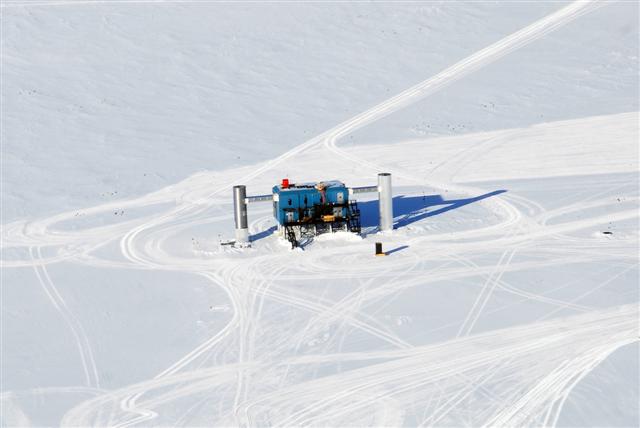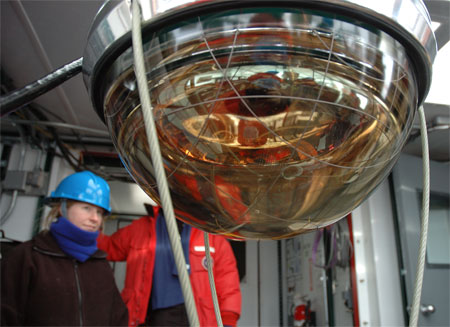|
Cool dealAgreement between NSF and UW-Madison takes IceCube Observatory to next phasePosted December 3, 2010
The National Science Foundation The collaborative agreement covers the cost of operating the observatory, located in the ice under the U.S. Amundsen-Scott South Pole Station Neutrinos come from the sun, cosmic rays interacting with the Earth’s atmosphere, and dramatic astronomical sources such as exploding stars in the Milky Way and other distant galaxies. By studying neutrinos, physicists can learn more about different processes underway in the universe. IceCube is the world’s largest neutrino detector. The size of the detector is important because it increases the number of potential collisions that can be observed, making neutrino astrophysics a reality. The final construction season is now underway, and the observatory is slated for completion in December. While the observatory is managed by UW-Madison under principal investigator Francis Halzen “The IceCube detector is a superb example of the kind of exciting ‘big science’ at the frontiers of knowledge that is ideally suited for support by the U.S. Antarctic Program Through OPP, NSF manages the USAP, which coordinates all U.S. research on the southernmost continent and surrounding oceans. “Although the IceCube project is primarily funded by the National Science Foundation, it exemplifies a modern trend in the increasingly complex and multidisciplinary scientific world,” Erb noted. “The large-scale projects like the IceCube detector are too complex to be effectively mounted by one nation alone, but also require the scientific and logistical expertise of many nations acting together to produce scientifically significant results.” Since 2004, the United States, Belgium, Germany and Sweden have been building the detector in the ice sheet that covers Antarctica to a depth of almost three kilometers in places. A powerful hot-water drill creates holes almost 2.5 kilometers deep into the ice. These holes house strings of digital optical modules that actually detect the interactions of the neutrinos with the ice. Seven holes remain to be drilled in December, which will bring the total to 86 strings. Even now, the IceCube detector records several tens of thousands of neutrino interactions every year. The detector records one terabyte of data — more than 1,000 gigabytes — every day and over a petabyte of data — quadrillion bytes — per year. Data are meticulously examined for evidence of neutrino events. The agreement with NSF covers the cost of operating the IceCube detector and managing the data it gathers in the United States, enabling researchers to acquire the highest quality scientific data and store it for further distribution. IceCube’s foreign collaborators also contribute to the detector’s maintenance and operation through in-kind support and contributions to a common fund. The Madison-based IceCube Research Center transforms the detector’s raw data to make it accessible for scientific analysis. “A secure, long-term funding plan is essential to a successful operations program. This award continues the strong partnership between NSF and UW that all of our collaborators depend upon,” said IceCube project director Jim Yeck. NSF-funded research in this story: Francis Halzen, University of Wisconsin-Madison, Award Nos. 0937462, 0236449, 0639286 and 0636875 |



For USAP Participants |
For The Public |
For Researchers and EducatorsContact UsNational Science FoundationOffice of Polar Programs Geosciences Directorate 2415 Eisenhower Avenue, Suite W7100 Alexandria, VA 22314 Sign up for the NSF Office of Polar Programs newsletter and events. Feedback Form |



